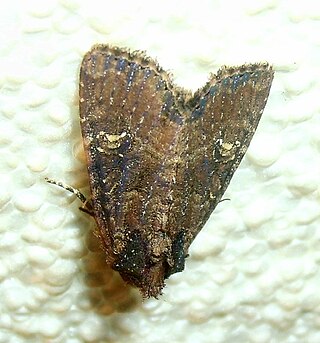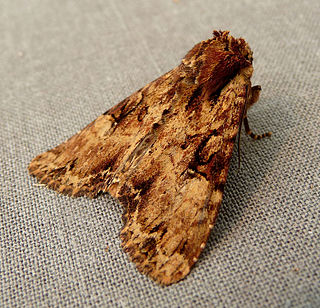
Apamea crenata, known as the clouded-bordered brindle, is a moth in the family Noctuidae. It is distributed throughout the Palearctic realm. In the North it crosses the Arctic Circle, in the Mediterranean it is found only in cool locations and mountains avoiding very hot areas. In the Alps, it rises to an altitude of about 2000 metres.

Apamea sordens, the rustic shoulder-knot or bordered apamea, is a moth of the family Noctuidae. The species was first described by Johann Siegfried Hufnagel in 1766. It is distributed throughout Europe, east across the Palearctic to Central Asia and to China and Japan. It also occurs in North America.

Apamea is a genus of moths in the family Noctuidae first described by Ferdinand Ochsenheimer in 1816.

Apamea ophiogramma, the double lobed, is a moth of the family Noctuidae. It is found in the Palearctic realm in North and Central Europe to the Urals, Turkestan, Russian Far East, and Siberia. There have been at least two separate introductions into North America and it is now rapidly expanding in range. This species is sometimes placed in the monotypic genus Lateroligia.

Apamea unanimis, the small clouded brindle, is a moth of the family Noctuidae. The species was first described by Jacob Hübner in 1813. It is native to Europe, Turkey, Azerbaijan, and western Siberia. It has been introduced in North America and can now be found in Ontario, Quebec, New Brunswick, New York, Michigan, and Wisconsin.
Apamea burgessi is a moth of the family Noctuidae. It is native to central North America, where it can be found throughout the Great Plains and Great Basin. Its distribution extends north to Alberta and south to Texas. There is a disjunct population on the East Coast of the United States.

Apamea zeta is a moth of the family Noctuidae. It has a Holarctic distribution, and can be found throughout the Northern Hemisphere. It occurs throughout Europe and the northern half of North America.

Apamea sublustris, the reddish light arches, is a moth of the family Noctuidae. The species was first described by Eugenius Johann Christoph Esper in 1788. It is found in central and southern Europe, Turkey and the Caucasus.

Apamea furva, the confused, is a moth of the family Noctuidae. The species was first described by Michael Denis and Ignaz Schiffermüller in 1775. It is found throughout Europe. In southwestern Europe it is primarily montane. It is found as far north as the Arctic Circle. From Europe its range extends to Siberia, Turkey, Iran, Kyrgyzstan, Mongolia and Xinjiang in China.
Camaegeria xanthopimplaeformis is a moth of the family Sesiidae. It is known from eastern Madagascar.
Megasis philippella is a species of snout moth in the genus Megasis. It was described by Pierre Viette in 1970, and is known from northern Madagascar.
Lamprosema rakotalis is a species of moth of the family Crambidae described by Pierre Viette in 1958. It can be found in Madagascar.
Lamprosema lucillalis is a species of moth of the family Crambidae described by Pierre Viette in 1958. It can be found in Madagascar.
Placosaris labordalis is a species of moth of the family Crambidae described by Pierre Viette in 1958. It is found in eastern Madagascar.
Apamea roedereri is a moth of the family Noctuidae. It is found in northern Madagascar.
Amphia sogai is a moth of the family Noctuidae first described by Pierre Viette in 1967. It is found in northern Madagascar.

Apamea epomidion, the clouded brindle, is a moth of the family Noctuidae, sub-family Hadeninae. The species was first described by Adrian Hardy Haworth in 1809. It is found throughout continental Europe, the British Isles, Sweden and Central Asia. It is also found in the Altai Mountains, west Siberia, and in Amur.
Autocharis librodalis is a species of moth of the family Crambidae described by Pierre Viette in 1958. It is found in Madagascar.
Autocharis phortalis is a species of moth of the family Crambidae. It was described by Pierre Viette in 1958 and is found on Madagascar.
Eoophyla limalis is a moth in the family Crambidae. It was described by Pierre Viette in 1957. It is found in Equatorial Guinea.








